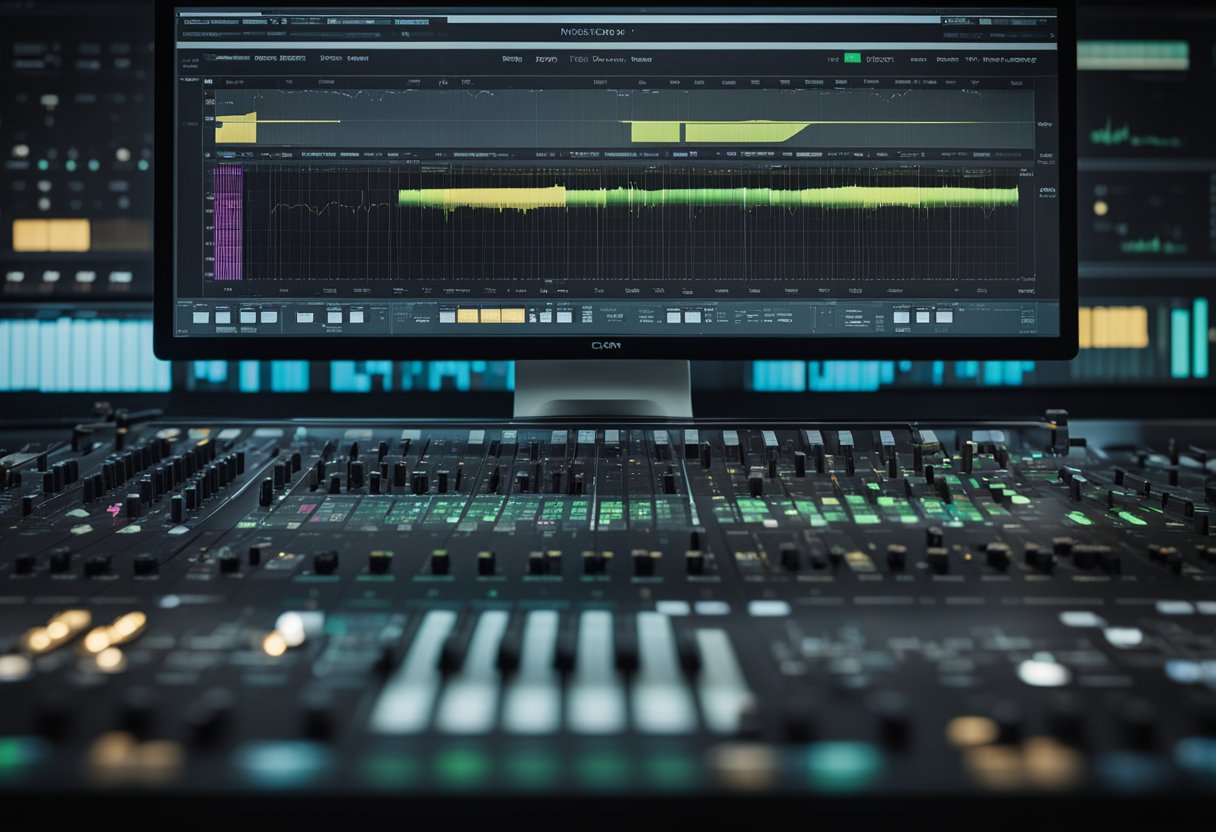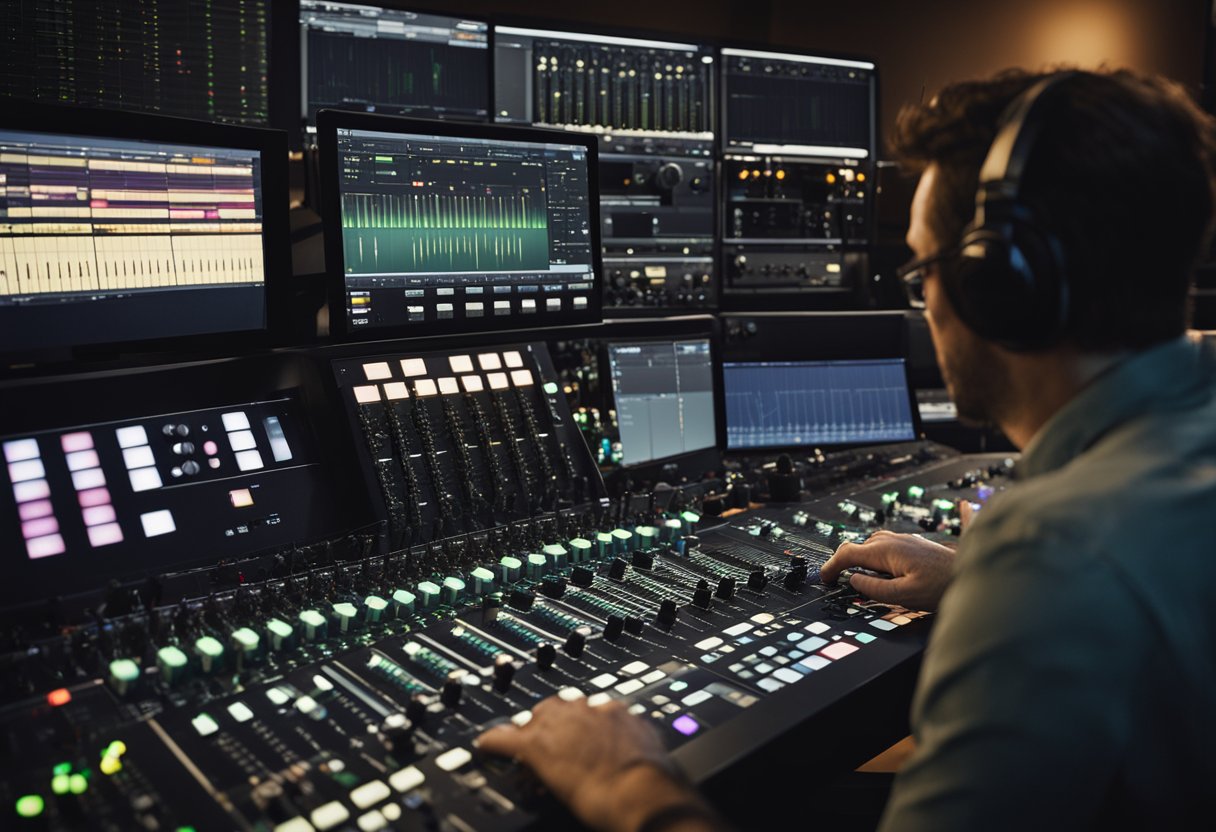Mastering engineering for music production is a crucial step towards achieving professional-grade sound quality in the music industry. The process involves a combination of technical and creative skills that require a deep understanding of sound engineering principles, music production software, and recording techniques. Whether you are a beginner or an experienced producer, mastering engineering is a continuous learning process that requires dedication and practice.
To master engineering for music production, one must first understand the fundamentals of sound engineering. This includes knowledge of sound waves, frequency, amplitude, and phase, as well as the use of equalizers, compressors, and other audio processing tools. Setting up your studio with the right equipment and acoustics is also essential for achieving optimal sound quality in your recordings.
Once you have a solid foundation in sound engineering, recording techniques, and studio setup, you can move on to mixing and mastering your music. This involves using music production software to edit, arrange, and enhance your recordings, as well as applying creative techniques to achieve your desired sound. Understanding the business of music production and continuing education are also important aspects of mastering engineering for music production.
Key Takeaways
- Mastering engineering for music production requires a combination of technical and creative skills.
- Understanding the fundamentals of sound engineering, setting up your studio, and using music production software are essential for achieving professional-grade sound quality.
- Mixing and mastering, as well as understanding the business of music production and continuing education, are also important aspects of mastering engineering for music production.
Fundamentals of Sound Engineering

Acoustic Principles
Acoustic principles are the foundation of sound engineering. Understanding how sound behaves in different environments is crucial to producing great music. Sound waves travel through the air and interact with the surfaces they encounter, causing reflections and echoes. The shape and size of a room can have a significant impact on the sound quality, so it’s important to choose the right space for recording and mixing.
Digital Audio Basics
Digital audio has revolutionized the way music is produced and recorded. It allows for precise editing and manipulation of sound, making it easier to achieve the desired results. Understanding the basics of digital audio is essential for any sound engineer. Sample rate, bit depth, and file formats are all important factors to consider when working with digital audio.
Signal Flow
Signal flow refers to the path that audio takes from the source to the output. It’s important to understand signal flow to be able to troubleshoot problems and optimize the sound quality. There are different types of signal flow, including analog and digital. Understanding the differences between them is crucial for sound engineering.
In summary, mastering the fundamentals of sound engineering is essential for producing high-quality music. Understanding acoustic principles, digital audio basics, and signal flow are key components of sound engineering. By applying this knowledge, sound engineers can achieve the desired results and create music that sounds great.
Setting Up Your Studio
Equipment Selection
When setting up a studio, selecting the right equipment is crucial. The equipment you choose will depend on the type of music you plan to produce. For example, if you plan to produce electronic music, you will need a synthesizer, drum machine, and MIDI controller. On the other hand, if you plan to produce live music, you will need microphones, a mixer, and speakers.
It’s important to invest in high-quality equipment, as this will affect the overall sound quality of your productions. However, it’s also important to stay within your budget. Researching and comparing different brands and models can help you find the best equipment for your needs and budget.
Room Acoustics and Treatment
The acoustics of your studio can greatly affect the sound quality of your recordings. When selecting a room for your studio, look for a space that has minimal echo and reverberation. You can also improve the acoustics of your studio by adding acoustic treatment, such as foam panels, bass traps, and diffusers.
It’s important to place your equipment and speakers in the right positions to optimize the acoustics of your studio. Experimenting with different speaker and equipment placements can help you find the best sound.
Ergonomics and Workflow
Creating a comfortable and efficient workspace is important for long studio sessions. When setting up your studio, consider the ergonomics of your workspace. This includes the height of your desk, chair, and equipment, as well as the placement of your computer monitor.
Creating an efficient workflow can also help you be more productive in the studio. This includes organizing your equipment and cables, creating templates for your projects, and using keyboard shortcuts to speed up your workflow. By optimizing your workspace and workflow, you can focus on creating great music.
Recording Techniques

Microphone Types and Placement
When it comes to recording music, choosing the right microphone and placement is crucial in capturing the desired sound. There are several types of microphones that are commonly used in music production, including dynamic, condenser, and ribbon microphones. Dynamic microphones are great for capturing loud sounds, such as drums or electric guitars, while condenser microphones are more sensitive and are often used for vocals and acoustic instruments. Ribbon microphones are known for their warm, vintage sound and are often used for recording brass and string instruments.
Proper microphone placement is also essential for achieving the desired sound. For example, placing a microphone close to the sound source will result in a more direct and intimate sound, while placing it farther away will create a more ambient and spacious sound. Experimenting with microphone placement can lead to unique and creative sounds.
Recording Different Instruments
Recording different instruments requires different techniques and considerations. For example, when recording drums, it’s important to consider the placement of microphones around the kit to capture each drum and cymbal. Recording acoustic guitars often involves using multiple microphones to capture different aspects of the sound, such as the body and the strings.
When recording vocals, it’s important to choose the right microphone and placement to capture the nuances of the singer’s voice. Additionally, using pop filters and other accessories can help eliminate unwanted sounds and improve the overall quality of the recording.
MIDI and Virtual Instruments
In addition to recording live instruments, many music producers also use MIDI and virtual instruments to create music. MIDI (Musical Instrument Digital Interface) is a protocol that allows electronic musical instruments to communicate with computers and other devices. Virtual instruments, on the other hand, are software programs that simulate the sound of real instruments.
Using MIDI and virtual instruments can be a great way to add depth and variety to a music production. With MIDI, producers can easily edit and manipulate notes, while virtual instruments offer a wide range of sounds and effects that can be used to create unique and interesting compositions.
Mixing and Mastering

Mixing Concepts and Strategies
Mixing is the process of combining individual tracks into a final stereo mix. It involves balancing the levels, panning, EQ, compression, and other audio effects to achieve a cohesive sound. The mixing engineer needs to have a good understanding of the music genre, the intended audience, and the artist’s vision to make the right decisions.
One of the key concepts in mixing is gain staging. This involves setting the levels of each track so that they are neither too loud nor too quiet. It is important to leave enough headroom for the mastering engineer to work with. Another important concept is frequency masking, where certain frequencies in one track can interfere with another track, causing muddiness or lack of clarity. EQ and panning can help to address this issue.
Mastering Techniques
Mastering is the final step in the music production process. It involves preparing the final mix for distribution by optimizing the overall volume, frequency balance, and stereo image. The mastering engineer needs to have a good listening environment, high-quality monitoring equipment, and an understanding of the different distribution formats and platforms.
One of the key techniques in mastering is loudness normalization. This involves adjusting the overall volume of the mix to match the desired level for the intended distribution format. Another important technique is EQ and compression, which can help to enhance the frequency balance and dynamic range of the mix. Stereo imaging and limiting are also important tools in mastering.
Audio Effects and Processing
Audio effects and processing are essential tools in both mixing and mastering. They can help to enhance the sound, create depth and space, and add character and emotion to the music. Some of the most common effects used in music production include reverb, delay, chorus, flanger, and distortion.
In mixing, effects are used to create a sense of space and depth, as well as to add interest and excitement to the music. In mastering, effects are used more sparingly, with the goal of enhancing the overall sound without detracting from the mix. It is important to use effects judiciously, with a clear understanding of their impact on the final sound.
Music Production Software
DAW Selection
The digital audio workstation (DAW) is the cornerstone of any music production software setup. It serves as the central hub for recording, editing, mixing, and mastering audio. When selecting a DAW, it’s important to consider the user interface, workflow, and compatibility with plugins and virtual instruments.
Popular DAWs such as Ableton Live, Logic Pro X, and Pro Tools offer unique features and strengths. Ableton Live is known for its intuitive session view and live performance capabilities, Logic Pro X for its comprehensive MIDI editing tools, and Pro Tools for its industry-standard mixing and mastering capabilities.
Plugins and Virtual Instruments
Plugins and virtual instruments are essential components of any music production software setup. They allow producers to add effects, synths, and other sounds to their tracks. When selecting plugins and virtual instruments, it’s important to consider compatibility with your DAW, quality of sound, and ease of use.
Native Instruments’ Komplete bundle is a popular choice for its extensive collection of high-quality plugins and virtual instruments. Other notable options include Waves’ plugins for their industry-standard sound processing capabilities and Serum for its versatile and powerful synth engine.
Sampling and Sound Libraries
Sampling and sound libraries provide producers with a vast array of sounds and samples to use in their productions. When selecting sampling and sound libraries, it’s important to consider the quality of the samples, compatibility with your DAW, and ease of use.
Splice is a popular choice for its extensive library of high-quality samples and loops. Other notable options include Kontakt for its extensive collection of sampled instruments, and Omnisphere for its vast array of unique and powerful sounds.
Overall, selecting the right music production software setup requires careful consideration of your specific needs and workflow. By selecting the right DAW, plugins, virtual instruments, and sound libraries, producers can achieve their desired sound and take their productions to the next level.
Creative Aspects of Production
Arrangement and Composition
The arrangement and composition of a music track are crucial aspects of music production. Mastering engineers need to have a good understanding of music theory, melody, harmony, and rhythm to create a cohesive and engaging track. They must also have a keen ear for identifying the strengths and weaknesses of a track and be able to make adjustments to enhance its musicality. By manipulating the arrangement and composition of a track, a mastering engineer can create a unique and memorable sound that stands out from the rest.
Sound Design
Sound design is the process of creating and manipulating sounds to achieve a desired effect. Mastering engineers must be able to use various tools and techniques to shape the sound of a track. They must have an in-depth knowledge of different sound sources, such as synthesizers, samplers, and acoustic instruments. They must also have a good understanding of signal processing, such as equalization, compression, and reverb, to create a polished and professional sound. By using creative sound design techniques, a mastering engineer can add depth and dimension to a track, making it more interesting and engaging.
Collaboration and Communication
Collaboration and communication are essential aspects of music production. Mastering engineers must be able to work closely with producers, artists, and other professionals in the music industry to achieve a desired outcome. They must be able to communicate effectively and clearly to ensure that everyone is on the same page. They must also be able to collaborate with others to create a cohesive and unified sound. By working collaboratively and communicating effectively, a mastering engineer can create a successful and memorable track.
In conclusion, mastering engineering for music production requires a wide range of creative skills and knowledge. By mastering the creative aspects of production, such as arrangement and composition, sound design, and collaboration and communication, a mastering engineer can create a unique and memorable sound that stands out from the rest.



